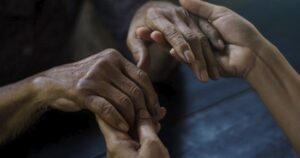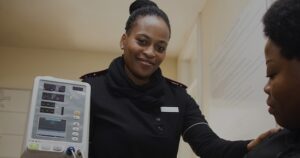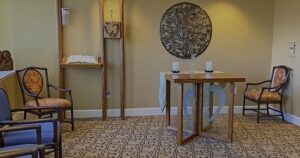Bathrooms can pose serious risks for a senior or anyone who is aging. Floors are tiled, surfaces are wet, the space is tight, and everything is made of hard materials. It’s no wonder that 80% of the millions of falls that happen after the age of 65 occur in the bathroom.
While bathrooms can be a dangerous place for elders, there are several things you can do to help your aging loved one stay safe there. These are eight tips you can use to improve bathroom safety for elderly people to ensure your loved one doesn’t become a statistic.
10 Bathroom Safety Tips for Seniors
Some bathroom safety hazards can be easily addressed with simple adjustments, while others may require more extensive renovations. It’s important to regularly evaluate the bathroom to assess your loved one’s evolving needs, especially as their mobility and health change over time.
1. Getting to the Bathroom
One thing that is often overlooked when it comes to senior bathroom safety is the path that leads to the bathroom. Since the bathroom is one of the most visited rooms of any house, making sure there’s a safe path to get there is important. Clear any major obstacles, such as bulky furniture, awkward display cases, or other objects that clutter the hallway and home.
Check to make sure the walking path to the bathroom is properly lit. This may require replacing low-light bulbs with brighter bulbs or adding extra lighting, such as night lights, to light the way when it’s dark.
Next, check the width of the doorway to the bathroom. Make sure your loved one can enter the bathroom with whatever walking assistance they may be using or need in the future, such as a walker or wheelchair. You may need to retrofit the entrance to make it more accommodating.
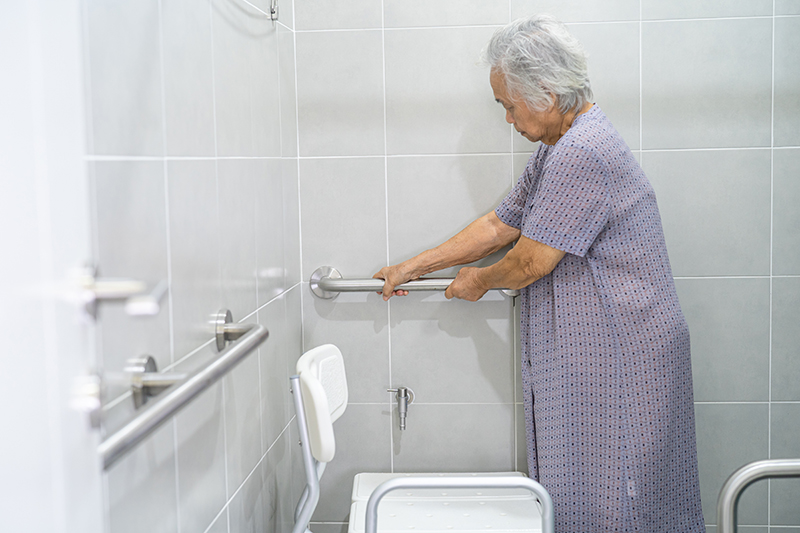
2. Walking on the Floors
Safe bathrooms for the elderly should feature non-slip flooring and low-profile bath mats. If the bathroom floor is slippery tile, you may want to consider having the floor replaced or covered with a less dangerous material, such as vinyl or bamboo. If you’re on a budget, non-slip mats to cover the floor will work as well, but you must ensure that any new mats don’t pose a trip or fall risk.
Make sure that anything on the floor is there for utility and not for decoration. Floor rugs that are there for comfort or decoration can lead to trips or falls and should be removed.
When you visit your loved one, run the bath, sink, and shower to check for any major leaks or areas where water gathers on the floor. Address any of these concerns to ensure the floor stays dry at all times.
3. Using the Shower
Many older adults get injured while getting in and out of the shower. Start off by assessing the physical shower space to see if your loved one can step in and out with ease. Shower safety for seniors hinges on this issue, which is why you may need to install a grab bar outside and inside the tub to increase the accessibility of the area.
If the shower is enclosed with doors, you may want to consider replacing the glass with safety glass or plastic to avoid further injury in the case of a fall. Being cut by glass will only worsen the situation.
Slipping in the shower is another scary issue you want to avoid, and you can do that by installing a non-slip mat in the bath or shower. Even an inexpensive mat can help an elderly person stay upright when they have balance or strength issues.
4. Using the Bathtub
Your loved one may insist on having a regular bath to reduce stress, and there are things you can do to make the space safe for them. Investigate the area around the bath and clear away any unnecessary clutter, especially any electric devices that could fall into the tub while your loved one is bathing.
It’s important to take bathtub safety for seniors seriously. If your loved one will be bathing often, it’s a good idea to install a grab bar and possibly even an emergency button to call for help.
5. Transferring From The Shower or Bath With a Bench
For seniors who have difficulty stepping into the shower or bathtub, a transfer bench can be a great solution. This bench allows your loved one to sit outside the tub and safely slide into the shower or bath without having to lift their legs over the edge. The added stability from the bench helps reduce the risk of falling while transitioning in and out of the bath or shower. Make sure to choose a bench that is sturdy, adjustable, and has non-slip feet for added safety.
6. Ensuring Safe Water Temperature
Unfortunately, an often-overlooked bathroom safety tip for seniors is water temperature. Being scalded by hot water is a common concern for seniors in the bathroom. Install a thermostatic mixing valve or an anti-scald device to regulate the water temperature and prevent sudden temperature changes that could cause burns. Make sure the water heater is set to a safe temperature (typically no higher than 120°F) to minimize the risk of burns during showers or baths. Regularly check the water temperature to ensure it’s within a comfortable and safe range.
7. Using the Toilet
Getting on and off the toilet can be hazardous for anyone who has strength or balance issues. If your loved one has difficulty getting up and down from the toilet, installing a raised toilet seat and toilet grab bars can greatly reduce their chances of falling and increase their ability to use the bathroom independently and safely.
When selecting grab bars, make sure to use heavy-duty, non-slip grab bars designed for bathroom use. Vertical or angled bars next to the toilet are often most effective for aiding in standing up, while horizontal bars can help with sitting down and maintaining balance. The bars should be installed at the proper height, typically about 33 to 36 inches from the floor, to ensure they are easy to grasp while seated or standing.
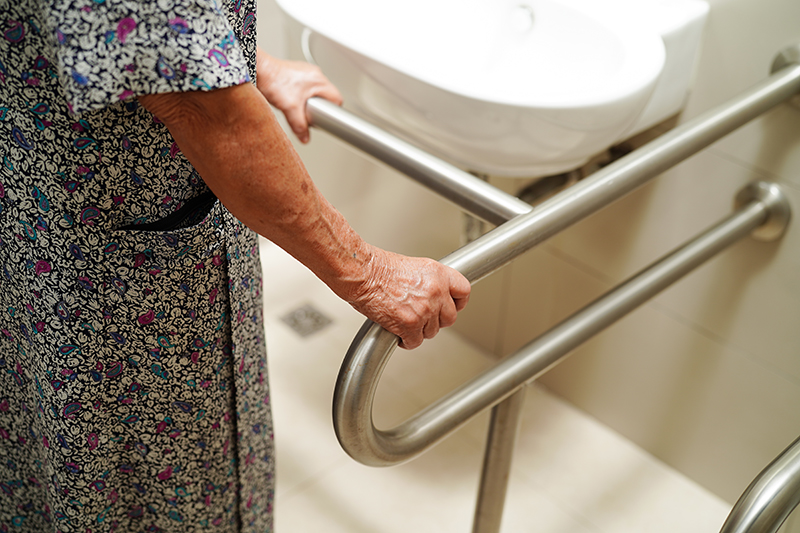
8. Adding Accessible Features
Accessible features such as grab bars and shower chairs are key elements of bathroom safety for elderly people. Older adults value independence, and renovating the bathroom or adding accessibility devices is a great way to help them maintain dignity while going about their daily activities.
You may consider removing the bathtub completely if stepping over is too much of a risk. A barrier-free shower is ideal for someone who uses a wheelchair or a walker. Speak to an expert on the best way to design and construct an accessible shower, and don’t forget to add in-shower seating, lever faucets, and hand-held shower hoses to complete the remodel.
Though it might be complex, you can explore the option of installing an emergency call button in the bathroom. If your loved one lives alone and experiences a fall, they will have access to an emergency line within reach.
9. Keeping Supplies Nearby
Ensure all the bathroom necessities your loved one might need are well within reach. This includes towels, toilet paper, extra toilet paper, washcloths, toothbrushes, and toothpaste. If your loved one has to reach over their head or use a step stool, find a new place to store toiletries or install new shelving solutions that are safer. Keeping these essentials within arm’s reach can prevent unnecessary stretching or bending, reducing the risk of falls.

10. Sitting Outside the Shower
From brushing teeth to fixing hair and makeup, there is often a lot of standing in the bathroom, which increases the risk of losing balance and falling. If the bathroom is big enough, consider an additional stool or seat that can make getting ready every day easier. If the bathroom is tight quarters, though, an additional seat will only create an additional tripping hazard, so be sure the space is big enough.
Alternatively, you can help your loved one organize their room or other living space to include a vanity or other area to get ready in the morning and unwind at night. This can encourage them to declutter the bathroom and find a more comfortable and safe place to finish up their hygiene routine.
Ensuring Bathroom Safety for Elderly Loved Ones
While some of the items listed above require tools and skill, most of these are quick and easy steps anyone can take to make the bathroom safer for an elderly loved one.
Shower and bathtub safety for seniors is a critical issue that can result in serious injuries and visits to the emergency room. Making items more accessible and installing non-slip mats will immediately eliminate a lot of the hazards in the bathroom. Remember to have a detailed discussion about these safety issues with your loved one and check on them frequently to ensure their bathroom environment is free of dangerous clutter, leaks, or mold.
There may come a time when your loved one requires additional care and attention. While it isn’t an easy decision to make, moving to an assisted living community or other care facility can have a positive impact on quality of life. If your loved one requires additional assistance, we’re happy to help. Click here to access our free assessment guide today!











